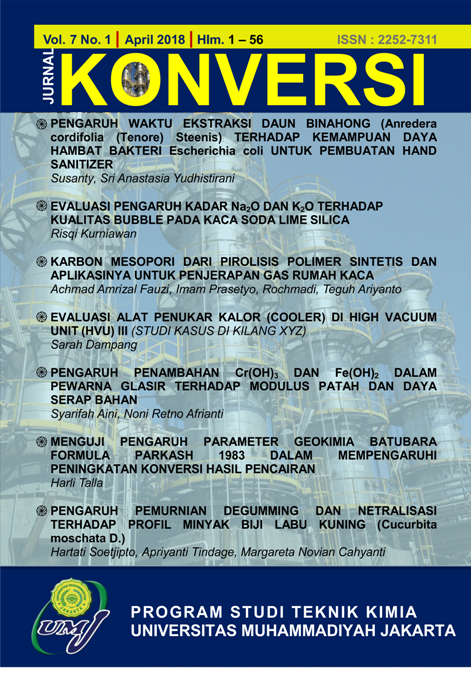PENGARUH WAKTU EKSTRAKSI DAUN BINAHONG (Anredera cordifolia (Tenore) Steenis) TERHADAP KEMAMPUAN DAYA HAMBAT BAKTERI Escherichia coli UNTUK PEMBUATAN HAND SANITIZER
Main Article Content
Abstract
Binahong leaf extract (Anredera cordifolia (Tenore) Steenis) contains active compounds such alkaloids, flavonoids, terpenoids, and saponins as antibiotic materials that can be used in the manufacture of antiseptic gel hand sanitizers. The purpose of this research is to know the effect of extraction time of binahong leaf to the capability of growth of Escherichia coli (E. Coli) bacteria. Variable times of exstractions are 0,5; 1; 1.5; 2; and 2.5 hours. Phytochemical qualitative test was conducted to determine the presence of alkaloids, flavonoids, terpenoids, and saponins in the binahong leaf extract. Furthermore, dilution of the results of rendement of binahong leaf extract respectively by 5% to test its inhibitory power to the growth of E. coli bacteria. The results showed that the yield of rendemen obtained by extraction time variable was 1.64%; 3.72%; 5.56%; 13.74%; and 13.98% are shown through the equation y = 3.47 x - 2.682 with the value R2 = 0.9049. Data from all five samples showed that samples with extraction time of 0.5; 1; and 1.5 hours had no inhibitory effect on E. coli bacteria growth, but samples with 2 and 2.5 hours extraction time had a resistance diameter of 14.5 and 18.5 mm. The sample which has the greatest inhibitory is subsequently used to make the hand sanitizer antiseptic gel. The product test analysis consists of organoleptic test and pH value determination, homogeneity, dispersion and viscosity. The results showed that the pH value obtained was 6.23, the homogeneity of the product can be seen from the absence of material that still agglomerates, the dissolving power of the research product is 5.5 cm, and the viscosity of the research result is 2080 mPs.
Article Details
Issue
Section
Articles
Authors who publish with this journal agree to the following terms:
- Authors retain copyright and grant the journal right of first publication with the work simultaneously licensed under a Creative Commons Attribution License that allows others to share the work with an acknowledgement of the work's authorship and initial publication in this journal.
- Authors are able to enter into separate, additional contractual arrangements for the non-exclusive distribution of the journal's published version of the work (e.g., post it to an institutional repository or publish it in a book), with an acknowledgement of its initial publication in this journal.
- Authors are permitted and encouraged to post their work online (e.g., in institutional repositories or on their website) prior to and during the submission process, as it can lead to productive exchanges, as well as earlier and greater citation of published work (See The Effect of Open Access).
